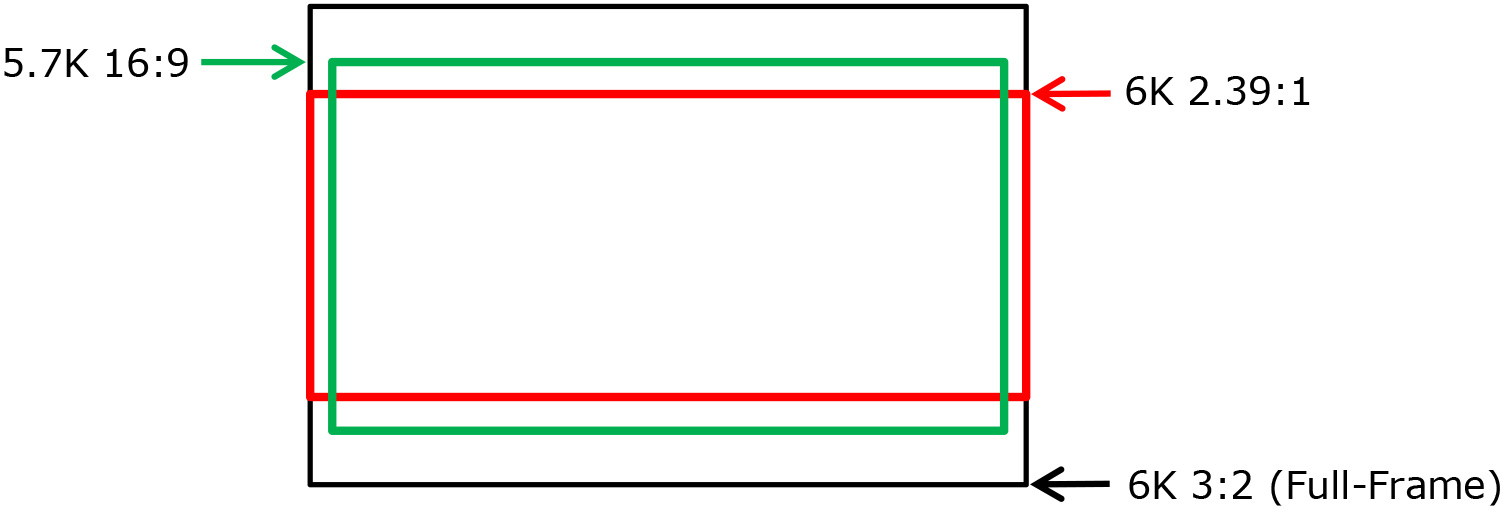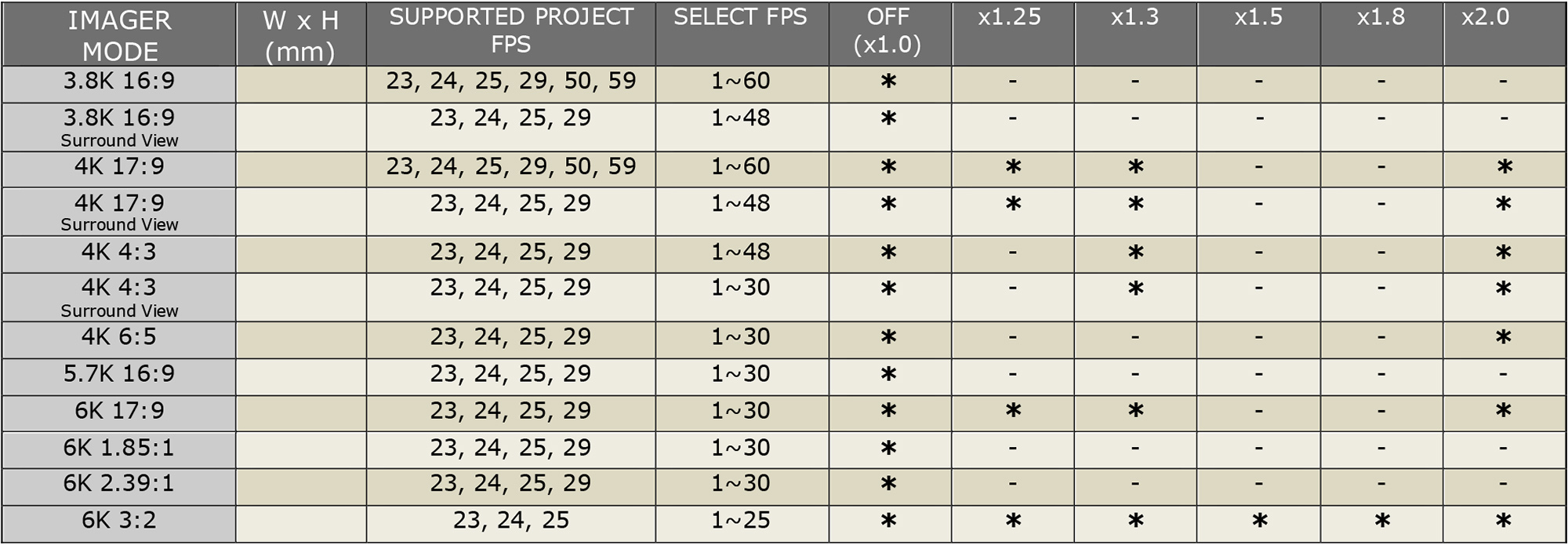First up is support for the VENICE Extension System, a tethered configuration that separates VENICE's svelte sensor block and lens mount assembly from the camera body via a 9-foot cable (with the option to reach an additional nine feet with an extension cable). All existing VENICE cameras, with the new firmware 3.0 installed, are compatible with the Extension System (aka CBK-3610XS). The Extension System is designed to be used with gimbals and other handheld stabilizers, underwater rigs, aerial applications and, well, just about anywhere you can think of where a full-size VENICE can't get to. We're excited to see what VENICE shooters do with the system.

On the camera features side of firmware 3.0, there are two new imager modes: 5.7K 16:9 as well as 6K (full-width) 2.39:1.

These two new modes allow those targeting either the familiar shape of 16:9 consumer televisions or the classic Cinemascope ratio to maximize the use of VENICE’s full format (36mm x 24mm) sensor while turning off unused photo sites to save on the total data rate. Both also oversample the image by roughly 30% when further scaled down to UHD or DCI 4K deliverable formats.
In addition to new imager modes, there’s also a new RAW recording format: X-OCN XT. X-OCN XT provides a virtually uncompressed file (and actually exceeds the data rate of Sony’s classic 16-bit linear RAW format, RAW SQ, in 3.8K 16:9 and 4K 17:9) while, like the initial X-OCN LT & ST "flavors," accommodating all VENICE sensor resolutions, including the two new ones noted above.

Note that the numbers in the chart above are given in megabits per second (Mb/s) at 24 fps. The top-end 23.98/24 fps data rate in X-OCN XT works out to some 2.6 gigabits per second, or nearly 330 megabytes per second. X-OCN XT obviously requires the AXS-R7 RAW recorder, and the faster S48 AXS media will be required for the following modes:
- 25 fps
- 6K 3:2 (2740 Mbps)
- 29.97(30p) fps
- 6K 1.85:1 (2678 Mbps)
- 6K 17:9 (2613 Mbps)
- 5.7K 16:9 (2613 Mbps)
- 23.98/24 fps
- 6K 3:2 (2631 Mbps)
X-OCN XT is designed for projects where file quality is of the utmost importance, such as for later compositing with CGI and other VFX tasks.
Also new is the ability to simultaneously record XAVC 4K and HD ProRes up to 422(HQ). Or, you could choose to record X-OCN and XAVC 4K at the same time. Both of the new simultaneous recording modes also support 4K monitoring – even when one of the recorded formats is HD, such as with ProRes.
Cache recording has also been enabled in firmware 3.0, allowing a maximum of 30 seconds of 4K (17:9) when shooting X-OCN or up to 8 seconds when shooting the full sensor (6K 3:2) using X-OCN (up to the ST "flavor"). Relay recording is also supported from one AXS card to another, just like with SxS. These are both great features, and we're happy to see them making their way to Sony's flagship CineAlta camera.
Anticipating the, shall we say, variety of different types of anamorphic lenses coming for full format (aka “full frame”) cameras in the near future (from Cooke, ServiceVision, Panavision, and others), VENICE now implements a wide range of de-squeeze factor options for viewing on the Monitor Out. It’s not quite “dial-a-squeeze,” but it’s close: 1.25x, 1.3x, 1.5x, and 1.8x (in addition to the existing standard 2.0x factor). The 1.8x option is especially noteworthy since it will support Cooke's new 1.8x Anamorphic/i Full Frame Plus lenses announced recently at IBC. Being the closest to the classic 'scope 2.0x squeeze factor, these new lenses look to provide the most elliptical bokehs and "vertical bias" when racking focus on large sensors. All of the new squeeze factors are available in the 6K 3:2 “full whack” sensor mode. To see which are supported in various other imager modes, have a look at the chart below:

A number of other "nice to haves" also appear in the update and help to solidify VENICE as a great full format option for projects at all levels of the business:
- Ability to change base ISO sensitivity from the Quick Access menu (under the EI section)
- CDL file import using SD card (similar to User 3D LUTs)
- 6G/12G-SDI switchable output during simultaneous RAW & HD recording
- Improved access to monitoring setup & configuration
- Improved support for the DVF-EL200 electronic viewfinder (camera-style menus in the viewfinder for its display and function options)
- Configurable False Color for both the EVF and Monitor Out
- Industry-standard folder & volume naming (CamID+Reel# option for both AXS & SxS, so they match, and — no more 'XDROOT'!)
- Standard 12-pin lens remote connector now outputs DC power for servo lenses
- 2:1 aspect ratio Frame Lines (Netflix’s most popular "alternative" aspect ratio)
- Reel and Shot values no longer blink following media format
- Wired and wireless (with CBK-WA02) network access to the full camera menu
Similar to version 2.0, the 3.0 update includes firmware bundles for both the camera body as well as the AXS-R7 RAW recorder. Be sure to read Ian McCausland's excellent piece about updating firmware on the AXS-R7 (especially if you're on a Mac).
Download firmware 3.0 now, and learn more about it, as well as the VENICE Extension System, in Sony's brochure.



















AbelCine encourages comments on our blog posts, as long as they are relevant and respectful in tone. To further professional dialog, we strongly encourage the use of real names. We reserve the right to remove any comments that violate our comment policy.
AbelCine publishes this blog as a free educational resource, and anyone may read the discussions posted here. However, if you want to join the conversation, please log in or register on our site.
We use Disqus to manage comments on this blog. If you already have a Disqus account registered under the same email as your AbelCine account, you will automatically be logged in when you sign in to our site. If not, please create a free account with Disqus using the same email as your AbelCine account.